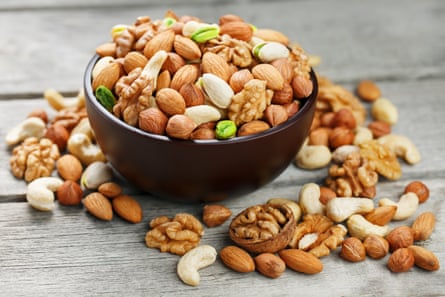How often do you eat nuts? The planetary health diet, introduced in 2019 and updated last month, recommends that everyone eat a portion every day (unless you have an allergy). Alongside eating more fruit, vegetables, whole grains and legumes, and fewer animal products and sugary foods, this could help prevent 40,000 early deaths a day across the world, as well as slash food-related greenhouse gas emissions.
Yet according to Prof Sarah Berry, the chief scientist at Zoe, many don’t eat any nuts at all. In the UK, the average consumption is 6g a day. Romanian researchers found higher levels of nut consumption in Canada, some African countries and some regions of Europe and the Middle East, and lower levels in South America. But overall, they said: “Consumers may not have a comprehensive understanding of the multiple benefits that nuts might bring.”
In particular, people are often put off nuts because they are high in fat. But in fact, say the researchers, “Nuts have been found to have positive health impacts, such as the potential to manage obesity and decrease the occurrence of cardiovascular disease, type 2 diabetes, several types of cancer and other chronic diseases associated with food.”
What explains this apparent paradox – and how can you get the most out of your daily peanuts, pecans or pistachios?
First, what counts as a nut?
While there are botanical quibbles, the 2024 book Nut Consumption and its Usefulness in the Modern World includes “tree nuts or fruit seeds with an edible grain and an indigestible hard shell”. In culinary terms, that most commonly means almonds, brazil nuts, cashews, chestnuts, hazelnuts, macadamias, peanuts, pecans, pine nuts, pistachios and walnuts.
How many of them should I eat, and how often?
“The recommended portion size is 30g every day, or at least five days a week. That’s a handful, so it’s easy to remember,” says Dr Sze-Yen Tan, a senior lecturer in nutrition science at Deakin University in Melbourne, Australia. It’s also the size of one of those little packs of peanuts you get in pubs. If you prefer nut butter, then it’s two tablespoons. Tan, who has authored a number of studies into the benefits of nuts, says he eats them almost every day – usually cashews or peanut butter.
Why are they good for me?

“Nuts are little nutritional powerhouses,” says Berry. “They are extremely nutrient-dense, packed with healthy fats, protein and fibre that can help stabilise your blood sugar, energy and hunger levels. They are also packed with micronutrients and vitamins.”
Eating nuts can reduce your risk of cardiovascular disease, she continues. “Studies have shown that people who eat a small handful of mixed nuts regularly have a significantly lower rate of heart attack, stroke and death from heart disease compared with a control group who were told to reduce their fat intake. So something as simple as adding a few nuts to your breakfast or snack can have big long-term benefits.”
And it doesn’t take long to see an improvement: “My study showed that swapping typical UK snacks for nuts can improve blood vessel function and lower cholesterol in as little as six weeks, resulting in a predicted 30% reduction in cardiovascular disease risk,” says Berry.
Are some nuts better than others?
“Nutritionally speaking, no matter which you prefer, all nuts are fantastic. Every serving contains unsaturated fats to support heart health, protein for satiety, fibre to aid digestion and feed beneficial gut bacteria, and polyphenols for their antioxidant properties,” says Berry.
“However, some types of nuts offer unique benefits. Brazil nuts, for example, are the best source of selenium; just one or two a day can meet your requirements for this essential element that helps fight cell damage. Walnuts contain the highest amount of the plant-based omega-3 fatty acid (ALA) among all nuts, which supports brain health and provides anti-inflammatory effects.” This makes them a great alternative for anyone who doesn’t eat oily fish.

“The colourful pigments in pistachios are important for protecting eye health,” continues Berry. “And almonds are some of the most nutrient-dense nuts. My own research shows that eating them instead of typical snacks may even improve cardiac function when we are under mental stress.” Tan adds peanuts to the list: “They contain high levels of vitamin E.”
In summary, says Berry, “Choosing a diverse mix of nuts is really the best course of action to ensure you get all the different health advantages they can provide.”
Are flavoured nuts still beneficial?
“Ideally, opt for plain or lightly roasted nuts most of the time, as many flavoured versions are loaded with added salt and sugar,” says Berry. “But healthy eating isn’t about perfection. If you love flavoured nuts, try making your own at home by roasting them with spices or herbs – or just buy the readymade ones every once in a while.”
What about nuts covered in chocolate?

Happily, “including chocolate-covered nuts in your diet – especially dark chocolate (70% cocoa or more) – can be a smart choice compared with skipping nuts altogether,” says Sammie Gill, a registered dietitian and British Dietetic Association spokesperson. “Dark chocolate provides greater health benefits than milk chocolate due to its higher polyphenol content and lower sugar levels, making it the more nutritious option. That said, eating snacks you enjoy matters too, so if you prefer milk chocolate nuts, have them. As with anything, the key is to be mindful of portion sizes. It’s all about how much and how often. Chocolate-covered nuts strike a nice balance between enjoyment and nutrition.”
Even chocolate-nut spread can be beneficial, Gill says – she recommends choosing one with a high nut and low sugar content, such as Pip & Nut’s Chocolate Hazelnut Spread (39% almonds, 24% hazelnuts) or Nut Blend’s Cacao, Cashew & Almond Butter. It’s well worth checking the label; some brands contain as little as 13% nuts.
Nuts are high in fat and calories. Won’t eating them every day make me put on weight?
“It’s a common misconception that eating nuts can make you put on weight,” says Berry. “People who eat nuts regularly often have lower body weight and less body fat. That’s partly because nuts are high in fibre and healthy fats, which help you feel full for longer – and less inclined to reach for the bag of crisps later on. But most importantly, we have shown that nuts have a special structure which means that about 25% of the calories remain undigested, so they are not as high-calorie as the back-of-pack labelling would suggest. This is also great news for our gut microbiome, as lots of intact nut cells end up in our large intestine providing great fuel for our microbes to feast on.”
Don’t be put off by the fat in nuts, says Gill. “Nuts are mistakenly perceived as unhealthy due to their high fat content (40-80%, depending on the type of nut). But ‘fat’ is a very broad term. Fat is an essential nutrient and there are different types. Healthy, unsaturated fats should make up the majority of all the fat we consume. The good news? Nuts primarily contain polyunsaturated and monounsaturated fats. For example, the majority of fats in peanuts – around 75-80% – are healthy, unsaturated fats.”
Tan is categorical. As long as you eat the recommended portion size, “All types of studies have shown that including nuts in our diet doesn’t lead to weight gain.”
Can I eat too many?
“It’s very easy to overeat nuts,” says Tan – especially the salted and flavoured kinds. “Prepackaged nuts can help.” (I think that’s true – somehow, I’m less likely to open a second 25g snack pack than I am to reach for another handful from a big bag.) But don’t worry too much if you have a second helping. “The main problem with overeating is simply the excess calories,” Tan continues. “Even though, for example, Brazil nuts are high in selenium, you’re not at risk of toxic levels.”
Gill makes the point that eating too much of any one food, including nuts, isn’t ideal. “Chances are you’re missing out on other key nutrients because you’re crowding out other foods and limiting overall diet diversity.” If you can stick to a handful of nuts a day, you’ll get all the benefits without any downsides.
Should I buy skin-on nuts?

Berry says yes, when possible and if you enjoy them. “The skins of nuts, including almonds and peanuts, contain many of the protective plant compounds – such as polyphenols and antioxidants – that help to reduce inflammation and oxidative stress. Around 60% of the skin is pure dietary fibre, which is essential for comfortable digestion and keeping your good gut bacteria happy.” Tan warns that the skin of some nuts can become bitter when roasted, though, so you may prefer blanched nuts sometimes.
Do I need to soak my nuts?
“Soaking or ‘activating’ nuts is a bit of a myth,” says Tan. “The idea was to remove some of the antinutrients [compounds that interfere with the absorption of nutrients], but studies show it doesn’t, and it can cause some food safety issues. That said, soaking can soften nuts for older people with dental problems.”
Gill agrees: “Soaking nuts is best done for personal preference in taste and texture, as nutritional changes – such as minor alterations in mineral and phytate content – are generally negligible.”
How do I cook with nuts?

If you tire of sprinkling them on your porridge or eating them as a snack, there are lots of ways to cook with nuts. “Nuts are very important in vegetarian and vegan diets to help meet protein requirements,” says Tan. The Guardian’s Meera Sodha uses them widely in her meat-free recipes. My recent favourites include tahini beans topped with pine nuts; walnut and tempeh noodles; lentils with chestnuts, red wine and cavolo nero; and leek, pistachio and jalapeño galettes. Sodha also uses cashews in a vegan mac’n’cheese; almonds in a pesto Trapanese with gnocchi; and peanut butter in a quick noodle sauce. Finally, her dark chocolate, date and pretzel slices also contain 100g of brazil nuts.
Are other nut-based products worth buying?
“Nut butters, nut milks and nut oils are a perfectly healthy addition to your daily diet,” says Gill. “I’d recommend a nut butter with as few ingredients as possible – look for jars that say ‘100% nuts’ on the label.” Tan says the most benefits come from whole nuts. “But for older people who may find them difficult to eat, nut butter can be really beneficial.”
There is an ever-growing range of nut milks available, from almond and cashew to hazelnut and pistachio. “Many nut-based milks are fortified with vitamins to better match the nutritional content of cow’s milk,” says Gill.
Should I give nuts to my children?
In the UK, NHS advice is that whole nuts should not be given to children under the age of five due to the risk of choking. Ground and crushed nuts, and nut butters, can be given to babies from six months old.

“Research indicates that tree nut allergies have increased in recent decades, with children generally showing a higher prevalence compared with adults,” says Gill. “It’s now widely accepted that babies should be introduced to allergenic foods – such as peanuts – at around six months old to help reduce the risk of developing allergies later on in life. Delaying introduction beyond six to 12 months may increase the risk.”
She adds: “Direct ingestion is the most common trigger of allergic reactions. Studies have shown that non-ingestion exposure – such as skin contact or inhalation of airborne nut particles – is very rare.” Of course, if you are ever asked not to eat nuts – on a plane with a severely allergic passenger, for example – then don’t.
Nuts are so expensive. How can I afford to eat them daily?
Peanuts tend to be the best value. For example, Tesco has 500g of redskin peanuts for £2.30.
With more expensive nuts, look out for “splits” (cashew nuts) and pieces (brazil nuts, walnuts, pecans), which are cheaper than whole nuts.
If you can, buy in bulk. For example, Grape Tree has 1kg of mixed nuts (walnuts, almonds, cashews and peanuts) for £9.99.
Look in the baking and world food aisles in supermarkets, where nuts are often cheaper than in the snack aisle.
Take advantage of promotions. Holland & Barrett, for example, usually has three-for-two deals on nuts, including pricey pistachios and macadamias.
Stock up on packs of cooked chestnuts in January – they are often reduced to clear after Christmas.

 3 hours ago
10
3 hours ago
10

















































